Chapter 10 – Sections & Objectives
- 10.0 Introduction
- 10.1 Application Layer Protocols
- Explain how the functions of the application layer, session layer, and presentation layer work together to provide network services to end user applications.
- Explain how common application layer protocols interact with end user applications.
- 10.2 Well-Known Application layer Protocols and Services
- Explain how web and email protocols operate.
- Explain how the IP addressing protocols operate.
- Explain how file transfer protocols operate.
- 10.3 Summary
10.1 Application Layer Protocols
Application, Presentation, Session
-
- Application Layer
- Closest to the end user.
- Application layer protocols help exchange data between programs running on the source and destination hosts.
- The TCP/IP application layer performs the functions of the upper three layers of the OSI model.
- Common application layer protocols include: HTTP, FTP, TFTP, DNS.
- Presentation and Session Layer
- Format data, compress and encrypt data
- Common standards for video include QuickTime and Motion Picture Experts Group (MPEG).
- Common graphic image formats are: GIF, JPEG and PNG
- The session layer creates and maintains dialogs between source and destination applications.
- The session layer handles the exchange of information to initiate dialogs, keep them active, and to restart sessions that are disrupted or idle.
- TCP/IP Application Layer Protocols
- TCP/IP application protocols specify the format and control information necessary for common Internet functions.
- Application layer protocols must be implemented in both the source and destination devices.
- Application layer protocols implemented on the source and destination host must be compatible to allow communication.
- Application Layer

How Application Protocols Interact with End-User Applications
-
- Client-Server Model
- Clients request information while servers provide it.
- Client and server processes are considered to be in the application layer.
- The contents of the data exchange will depend of the application in use.
- Email is an example of a Client-Server interaction.
- Peer-to-Peer Networks
- Data is accessed without the use of a dedicated server.
- Two or more computers can be connected to a P2P network to share resources.
- Every connected end device (a peer) can function as both a server and a client.
- The roles of client and server are set on a per-request basis.
- Client-Server Model
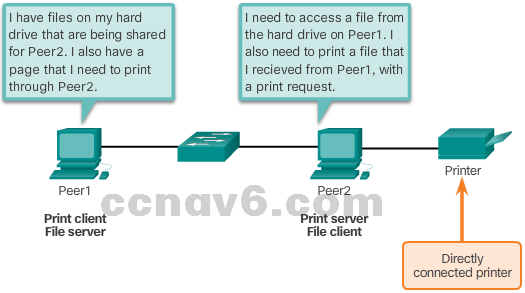
- Peer-to-Peer Applications
- Some P2P applications use a hybrid system, where resource sharing is decentralized.
- Indexes that point to resource locations are stored in a centralized directory.
- In a hybrid system, each peer accesses an index server to get the location of a resource stored on another peer.
- Common P2P Applications
- Common P2P networks include: eDonkey, G2, BitTorrent.
- Many P2P applications allow users to share pieces of many files with each other at the same time.
- A small torrent file contains information about the location of other users and tracker computers.
- Trackers are computers keeping track of the files hosted by users.
- This technology is called BitTorrent. There are many BitTorrent clients, including BitTorrent, uTorrent, Frostwire, and qBittorrent.
10.2 Well-Known Application Layer Protocols and Services
Web and Email Protocols
-
- Hypertext transfer Protocol and Hypertext Markup Language
- A URL is a reference to a web server.
- URLs and URIs are the names most people associate with web addresses.
- URLs contain the protocol, the server name and the requested filename.
- Using DNS, the server name portion of the URL is then translated to the associated IP address before the server can be contacted.
- HTTP and HTTPS
- The browser sends a GET request to the server’s IP address and asks for the index.html file.
- The server sends the requested file to the client.
- The index.html was specified in the URL and contains the HTML code for this web page.
- The browser processes the HTML code and formats the page for the browser window based on the code in the file.
- HTTP Is not secure. Messages can be intercepted.
- HTTPS uses authentication and encryption to secure data.
- Email Protocols
- Email is a store-and-forward method of sending, storing, and retrieving electronic messages.
- Email messages are stored on mail servers.
- Email clients communicate with mail servers to send and receive email.
- Mail servers communicate with other mail servers to transport messages from one domain to another.
- Email relies on three separate protocols for operation: SMTP,POP and IMAP.
- SMTP Operation
- SMTP message formats require a message header and body.
- The header must have a properly formatted recipient email address and a sender address.
- An SMTP client sends an email by connecting to a SMTP server on port 25.
- The server receives the message and stores it in a local mailbox or relays the message to another mail server.
- Users use email clients to retrieve messages stored on the server.
- POP Operation
- Messages are downloaded from the server to the client.
- Email clients direct their POP requests to mail servers on port TCP 110.
- POP allows for email messages to be downloaded to the client’s device (computer or phone) and removed from the server.
- A downloaded message resides on the device that triggered the download.
- IMAP Protocols
- IMAP is another protocol used to retrieve email messages.
- Allows for messages to be displayed to the user rather than downloaded.
- The original messages reside on the server until manually deleted by the user.
- Users view copies of the messages in their email client software.
- Support folder hierarchy to organize and store mail.
- When a user decides to delete a message, the server synchronizes that action and deletes the message from the server.
- Hypertext transfer Protocol and Hypertext Markup Language
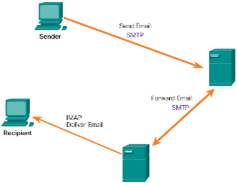
IP Addressing Services
-
- Domain Name Service
- IP addresses are not easy to memorize.
- Domain names make server addresses more user-friendly.
- Computers still need the actual numeric address before they can communicate.
- The DNS protocol allows for the dynamic translation of a domain name into the associated IP address.
- DNS Message Format
- Common DNS records are A, NS, AAAA and MX.
- DNS servers search its own records first, relaying the client’s request to other servers if it can’t resolve the request.
- The response is then forwarded to the client.
- The client often stores previous name resolutions. Use the ipconfig /displaydns to list cached DNS entries on Windows.
- Domain Name Service

-
- DNS Hierarchy
- The DNS protocol uses a hierarchical system.
- The naming structure is broken down into small, manageable zones.
- Each DNS server is only responsible for managing name-to-IP mappings for a small portion of the DNS structure.
- Requests for zones not stored in a specific DNS server are forwarded to other servers for translation.
- Top-level domains represent either the type of domain or the country of origin. Examples of top-level domains are .com, .org, .au and .co
- The nslookup Command
- Use nslookup to place DNS queries.
- Useful for DNS troubleshooting.
- DNS Hierarchy
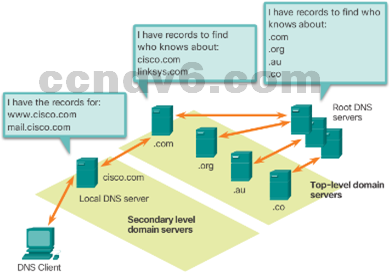
-
- Dynamic Host Configuration Protocol
- Computers need network IP information to communicate over a network.
- IP information include host and gateway addresses, mask, and DNS server.
- DHCP allows for automated and scalable distribution of IP information.
- DHCP-distributed addresses are leased for a set period of time.
- Addresses are returned to the pool for reuse when no longer in use.
- DHCP supports IPv4 and DHCPv6 supports IPv6.
- DHCP Operation
- The client broadcasts a DHCPDISCOVER.
- A DHCP server replies with DHCPOFFER.
- The client sends a DHCPREQUEST message to the server it wants to use (in case of multiple offers).
- A client may also request an address previously been allocated by the server.
- The server returns a DHCPACK to confirm the lease has been finalized.
- Dynamic Host Configuration Protocol
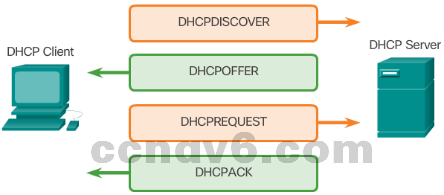
File Sharing Services
-
- File Transfer Protocol
- FTP was developed to allow the transfer of files over the network.
- An FTP client is an application that runs on a client computer used to push and pull data from an FTP server.
- FTP requires two connections between the client and the server: one connection for commands and replies and another connection for the actual file transfer.
- The client initiates and establishes the first connection to the server for control traffic on TCP port 21.
- The client then establishes the second connection to the server for the actual data transfer on TCP port 20.
- The client can download (pull) data from the server or upload (push) data to the server.
- File Transfer Protocol
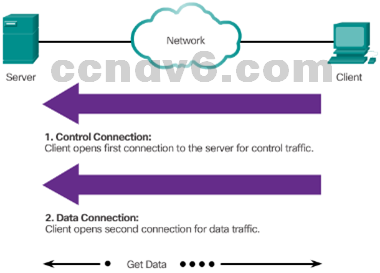
-
- Server Message Block
- SMB is a client/server file sharing protocol.
- All SMB messages share a common format.
- SMB file-sharing and print services have become the mainstay of Windows networking.
- Microsoft products now support TCP/IP protocols to directly support SMB resource sharing.
- After the connection is established, the user of the client can access the resources on the server as if the resource is local to the client host.
- The Mac, LINUX, and UNIX operating systems have their own implementation of SMB.
- Server Message Block
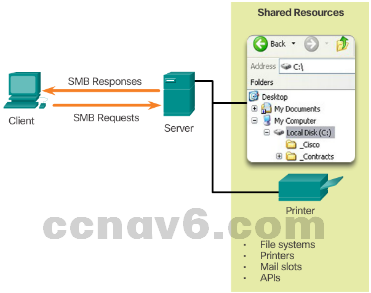
10.3 Summary
Summary
- Explain the operation of the application layer in providing support to end-user applications.
- Explain how well-known TCP/IP application layer protocols and services operate.
Chapter 10 New Terms and Commands
- Hypertext Transfer Protocol (HTTP)
- File Transfer Protocol (FTP)
- Trivial File Transfer Protocol (TFTP)
- Internet Message Access Protocol (IMAP)
- Domain Name System (DNS)
- Simple Mail Transport Protocol (SMTP)
- Post Office Protocol (POP)
- Dynamic Host Configuration Protocol (DHCP)
- QuickTime and Motion Picture Experts Group (MPEG)
- Graphics Interchange Format (GIF)
- Joint Photographic Experts Group (JPEG)
- Portable Network Graphics (PNG)
- BOOTP
- HTTPS
- Client-server model
- Peer-to-peer network (P2P)
- P2P networks
- P2P applications
- Gnutella protocol
- BitTorrent
- Uniform Resource Locator (URL)
- Uniform Resource Identifier (URIs)
- Get
- Post
- Put
- HTTP Secure (HTTPS)
- Secure Socket Layer (SSL)
- Simple Mail Transfer Protocol (SMTP)
- Post Office Protocol (POP)
Chapter 10 New Terms and Commands
- IMAP
- Port 25 (SMTP)
- TCP Port 110 (POP)
- Domain name
- DNS Protocol
- Record types: A, NS, AAAA, MX
- ipconfig /displaydns
- Top-level domains are: .com, .org, .au, .co
- 10.2.2.4
- Nslookup
- 10.2.2.5
- Dynamic Host Configuration Protocol (DHCP) for IPv4
- DHCPv6
- 10.2.2.6
- DHCP Discover
- DHCP Offer
- DHCP Request
- DHCP Acknowledgement
- DHCP Negative Acknowledgement
- DHCPv6: SOLICIT, ADVERTISE, INFORMATION REQUEST, and REPLY
- 10.2.3.1
- FTP daemon (FTPd)
- 10.2.3.2
- Server Message Block (SMB)
